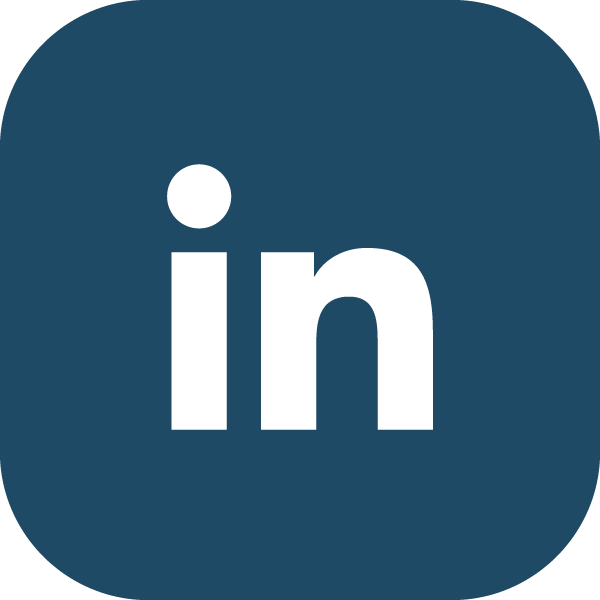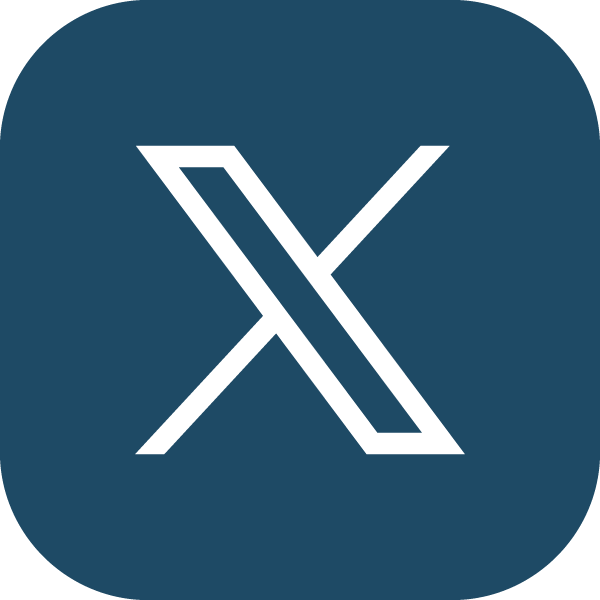The singing Tesla coil
Music at high voltage
A Tesla coil that makes music besides flashes of lightning? No problem for Silvio Müller and Yanis Strüby, apprentice physics laboratory technicians at Empa. With their singing Tesla coil, they won both the jury and the participant award at the «Züri-Oberland» apprentice competition.

Tesla coils are fascinating. These electrical transformers generate a high voltage – complete with lightning bolts and the smell of ozone. Due to their low power, however, the light show is usually harmless, and Tesla coils have become crowd pullers in museums and at science shows.
Yanis Strüby and Silvio Müller, who are in the third year of their apprenticeship as physics laboratory technicians at Empa, shared this fascination. They decided to build a Tesla coil for the «Züri-Oberland» apprentice competition (LWZO). But lightning alone was not enough for the Empa lab technicians-to-be: Their coil should also play music. Last November at the LWZO in Wetzikon, they not only impressed the expert jury, but also their fellow competitors, the other apprentices – and won both the jury and the participant award.
Both handmade and high-tech
The road to victory was anything but easy. The project had to be researched, planned, calculated, manufactured and tested. The apprentices wound the actual coil by hand: almost 2,000 turns, a total of around 350 meters of copper wire. "We had to be very careful because the wire was very thin and we didn't want it to break," recalls Müller. "It was the first big project of our own and certainly a test of patience," adds Strüby. "But we made it – and we learned that we work very well together under pressure."
Their vocational trainer, Dominik Bachmann, research engineer in Empa's Transport at Nanoscale Interfaces laboratory, encouraged the apprentices to participate at the LWZO – but the idea of the singing Tesla coil, Bachmann stresses, was entirely theirs. "At times, I had to read up on it myself before I could answer their questions," he smiles.
The senior apprentices at Empa were also a source of inspiration to Strüby and Müller: Sofie Gnannt and Nick Cáceres won the LWZO as well as other competitions last year. "These competitions are a cool experience for the apprentices – and good preparation for their individual practical work, one of the requirements to complete their apprenticeship," says Bachmann. Strüby and Müller also enjoyed the exchange with apprentices from various professions. They have already warmly recommended participation in the competition to junior apprentices at Empa.
Success through teamwork and mentoring
Anna Ettlin
Communications
Phone +41 58 765 4733
redaktion@empa.ch
Physics lab apprenticeship at Empa Transport at Nanoscale Interfaces Lab
Apprenticeship at Empa
Open Lab Day
On September 14, 2024, Empa Dübendorf will open the doors of its laboratories to the public. At over 70 stations, visitors will be able to experience current Empa research live on topics such as climate change, the energy transition, human and environmental health and much more. The stories in this issue give a small taste of the variety of materials and technologies that are discovered, researched, and developed in Empa's laboratories. Hungry for more? Visit us on September 14!
Read the latest EmpaQuarterly online or download the PDF version.
The Empa summer camp 2024
Research adventure for future STEM professionals
The first week of summer vacation in Zurich is summer camp time at Empa! The 20-plus slots for the children of Empa employees were once again in great demand and quickly booked out. In various workshops, the children immersed themselves in the professional world of their parents, the engineers and materials scientists at Empa. In addition to the “work” in the laboratory, there was of course also plenty of fun and relaxed excursions.
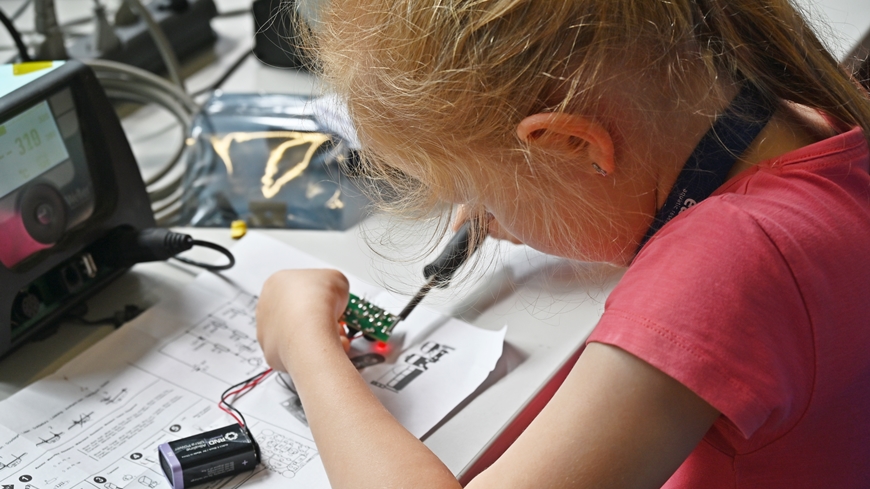
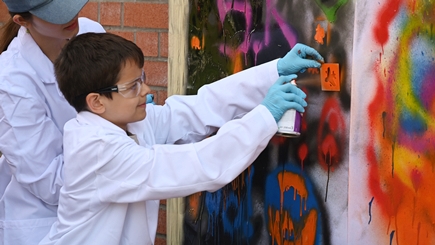
With its summer camp, Empa wants to arouse children's interest in the so-called STEM topics such as computer and natural sciences, technology and mathematics. While their parents worked in their labs and offices at Empa, 24 children of primary school age spent a week trying their hand at being up-and-coming engineers and materials scientists.
They had fun building a car with an environmentally friendly balloon drive, making a rocket engine and learning how to handle nitrogen safely. They were amazed by the fact that an electron microscope makes the smallest things appear very large, giving them a glimpse into the micro-universe. When building an insect hotel, the children “enjoyed thinking about where which part can be ‘measured’ so that it creates a coherent picture afterwards”, explains Peter Ebschner, leader of the Upcycling workshop. And they learned that discarded and used items do not necessarily have to be waste.
The experiments were an exciting and educational part of the summer camp, but often required a lot of concentration and a certain amount of discipline. As a counter-balance, the afternoons were filled with physical activities including a scavenger hunt, during which the extensive new campus could be explored.
Eröffnung des Forschungscampus «co-operate»
Raum für zukunftsweisende Innovationen
Der gemeinsame Campus der Empa und Eawag ist angewachsen: drei moderne Gebäude rund um NEST, ein Kunstwerk aus acht Findlingen und ein neuer Grüngürtel mit über 100 Bäumen erweitern das Areal. Mehr Platz also für (noch mehr) Innovationen und mehr Komfort, Attraktivität und Sicherheit für Mitarbeitende und Gäste. Ende Juni 2024 wurde «co-operate» mit allen Projektpartnern feierlich eröffnet.
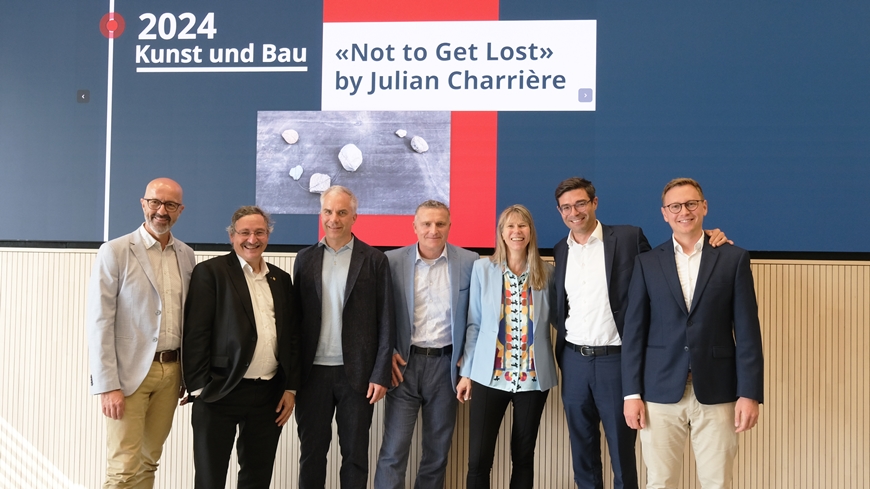
Der neue Forschungscampus «co-operate» der Empa und Eawag ist offiziell eingeweiht: Am 25. Juni 2024 fand die Eröffnungsfeier mit allen Projektpartnern statt und markierte den feierlichen Abschluss der Bauarbeiten. Nach einer intensiven Bauphase von 2021 bis 2024 sind die drei neuen Gebäude nun in Betrieb: Ein modernes Laborgebäude bietet Platz für Forschung in rund 30 Laboratorien und ebenso vielen Büros. Das Multifunktionsgebäude verfügt über rund 1000 Quadratmeter Bürofläche, Aufenthalts- und Coworking-Bereiche sowie das Bistro «Flair» im Erdgeschoss. Mit 260 neuen Parkplätzen reduziert das Parkhaus den Verkehr auf dem Areal und fördert somit das «Campus-Feeling», das zusätzlich durch den neuen Grüngürtel mit über 100 neuen Bäumen verstärkt wird. Diese Weiterentwicklung des Campus in Dübendorf war laut Empa-Direktorin Tanja Zimmermann wichtig, um weiterhin gemeinsam Spitzenforschung zu betreiben. Der Name des neuen Forschungscampus der Empa und Eawag – «co-operate» – greift diese Entwicklung auf.
Innovationszyklen und nachhaltige Bauweise
«Drei Hauptziele wurden mit dem Projekt «co-operate» erreicht», erklärte Andrea Gubler der SAM Architekten AG an der Eröffnung: Die neuen Gebäude vereinen zwei Welten. Auf der einen Seite stehen moderne Forschungslabore, die den heutigen Standards entsprechen und wenig Gestaltungsspielraum für die Baupläne bieten. Auf der anderen Seite wurden besondere Räume geschaffen, die den Menschen und den Austausch untereinander in den Vordergrund stellen. Diese Räume zeichnen sich durch eine andere Ästhetik aus, bestehen aus Materialien wie Naturholz und Textilien und bieten eine weichere Formsprache. Das zweite erreichte Ziel ist die Nachhaltigkeit in «co-operate»: Ein herausragendes Beispiel dafür ist das neue Holz-Hybrid-Parkhaus. Das Gebäude wurde bereits heute so konzipiert, dass es künftig leicht in Arbeitsräume umgewandelt werden kann. Diese nachhaltige Bauweise unterstreicht die langfristige Planung des Campus. Auf einer grösseren Skale der städtebaulichen Ebenen zeigt sich das dritte Ziel: Die bestehenden Strukturen wurden in einer neuen Form als Forschungscampus weiterentwickelt. Im Zentrum stehen grosse und kleine Begegnungsorte, die den Austausch und die Interaktion ermöglichen.
Für heutige und zukünftige Innovationen
Der Präsident des ETH-Rats, Michael Hengartner, hob an der Eröffnungsfeier die Wichtigkeit von durchdachten Bauprojekten hervor: «Forschung braucht Raum – Raum ist teuer. In Zeiten von knappen Mitteln ist es daher selbstverständlich, dass man effizient und zweckmässig baut. Das ist mit dem Projekt «co-operate» sehr gut gelungen. Herzliche Gratulation!»
Verbunden werden die neuen Gebäude durch das Kunstwerk «Not to get lost» des international renommierten Künstlers Julien Charrière. Acht zusammengesetzte Findlinge, in deren Rücken sich Steinkeile bohren, schlängeln sich über den Beton zwischen NEST und Laborgebäude. Friederike Schmid stellte, in Vertretung des Künstlers, das Kunstwerk an der Eröffnungsfeier vor: «Empa und Eawag wollen mit diesem Werk einen augenzwinkernden Impuls an die Forschenden senden – den Weg der Wissenschaft, der manchmal auch über «felsiges Gelände» führen kann, mit etwas Leichtigkeit zu nehmen und den spielerischen Fluss dieser Installation zu umarmen.» Neben dem Werk ergänzt auch der «Grüngürtel» den Forschungscampus, der sich vom neuen Laborgebäude bis zur Eawag zieht und mit gemütlichen Bänken Erholungsraum schafft.
Mit der Eröffnungsfeier ist der Forschungscampus «co-operate» nun voll funktionsfähig und bietet eine zukunftsweisende Umgebung, die den Anforderungen modernster Forschung gerecht werden. Der Campus ist ein Ort für heutige und zukünftige Innovationen, der durch moderne Infrastruktur und nachhaltige Bauweise besticht und den Austausch sowie die Interaktion fördert.
Kevin Olas
Immobilien, Empa
Tel. +41 58 765 41 64
kevin.olas@empa.ch
Vlatko Biljaka
Immobilien, Empa
Tel. +41 58 765 60 16



